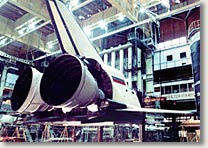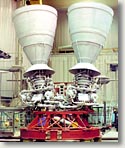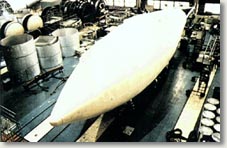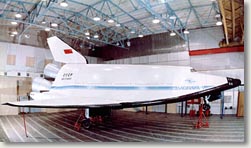MAKS multipurpose aerospace system has a number of fundamental advantages. In the
first place it is a capability of putting payloads into any inclination orbits, high
operation efficiency and low operational cost and absence of necessity to alienate areas
under fields of fall of construction components.
Unlike the rocket systems tied to few space vehicle launching sites and limited in
orbit choice, MAKS may be used for emergency rescue of space object crews or for urgent
aerial reconnaissance of regions of technogene and natural extraordinary situations.
| NPO MOLNIYA began to realize the MAKS project in the 1980s before the
BURAN orbiter first flight
using the experience and results of work on the SPIRAL project,
the BOR experimental flight vehicles and the BURAN. Up to date
the main components of the orbital stage construction have been worked up, external fuel
tank mock-up has been made, significant work has been already done on the propulsion
system MAKS consists of the subsonic carrier aircraft and an orbital stage with an
external fuel tank mounted on it As the first stage the An-225 MRIA aircraft originally
intended for the BURAN transportation is used. |
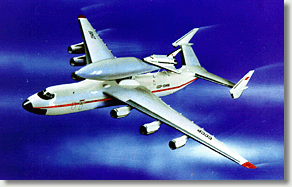
|
The second stage of the system has three modifications: MAKS-OS, MAKS-T and
MAKS-M. The MAKS-OS second stage consists of a reusable orbital vehicle and an expendable
fuel tank. The main propulsion engine includes two RD-701 engines
using three-component fuel (liquid hydrogen, kerosene, and liquid oxygen). The base manned
variant of the MAKS-OS vehicle has a two-seat crew cabin.
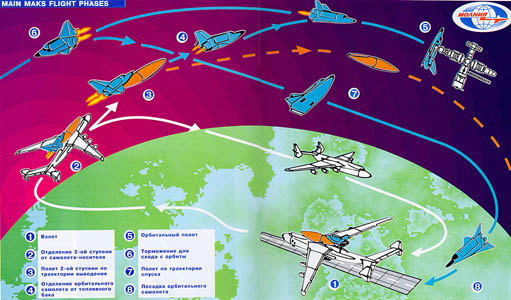
The MAKS versions for transport-technical provision are developed. TTO-1 version
is equipped with a docking module and the second four-seat pressurized cabin. TTO-2
version is intended for delivery in an unpressurized equipment compart-ment mounted on the
external side of orbital stations.
The MAKS-T modification with the expendable unmanned second stage is intended to
put into orbit heavy (up to 18 tons) payloads. It uses the same external fuel tank, as in
MAKS-OS, where the propulsion engine with payload closed by fairing is installed instead
of the orbital vehicle.
The MAKS-M second stage is the reusable unmanned orbital vehicle. The MAKS-M fuel
tanks are included in the vehicle construction.
MAKS-M - the development of which is connected with solving complex technological
problems is regarded as possible further direction of MAKS concept when the first two
modifications were fully developed.
As fast as MAKS-OS, -T and -M are created they should be incorporated into the
joint operation on the basis of a common carrier aircraft and the ground infrastructure.
Reusability of their components and the high degree of orbital stage unification provide
achievement of the main aim for developers drastic reduction of the transport space
operation cost compared with the existing systems.
For decrease of technical risk of the full-scale MAKS creation and regular time
distribution of financial expenditures the production of a comparatively inexpensive
experimental technology demonstrator system was considered necessary.
Researches on the first demonstrator version (RADEM) were carried out by NPO
MOLNIYA together with British Aerospace, ANTK Antonov and TCAGI under sponsorship of the
European Space Agency (ESA) in 1993-94.
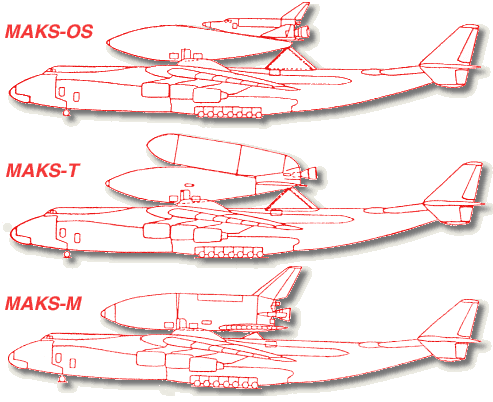
The up-to-date version of the MAKS-D demonstrator was also developed using what
was already done on the RADEM and on the basis of the MAKS-OS construction and aerodynamic
configuration. The experimental vehicle takeoff weight - 62,3 tons, landing weight - 12,8
tons. Unlike RADEM, the MAKS-D suborbital vehicle propulsion engine consists of only one
oxygen-kerosene engine that not only simplifies the project, but also increases the
demonstrator power capability at the given tank volumes. Wide unification of MAKS-D and
MAKS-OS vehicles onboard systems is stipulated.
The accepted MAKS-D concept stipulates a possibility to use it for putting into
orbit of small payloads. For this purpose the system is supplemented by a rocket stage.
With the aid of the demonstrator the technologies and components of the MAKS launch system
will be worked up and the carrier prestart manoeuvre, stages separation, an initial phase
of launch and the orbital stage automatic landing will be researched in real conditions.
Besides it may be used as a flying laboratory for advanced air-breathing engine tests.
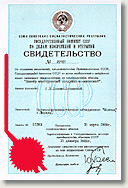
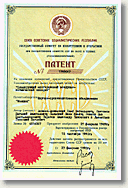
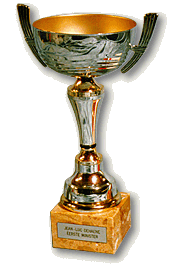
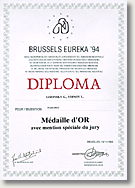
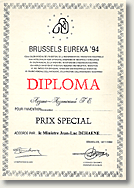
Reusable aerospace systems are developed now in many countries, however, in
opinion of a number of foreign experts Russia has advanced on this way farther than its
competitors. The possession of such system as MAKS would help Russia to take firm position
in the space service market at the beginning of the new century.
Main characteristics of the MAKS modifications |
| Modifications |
MAKS-OS |
MAKS-T |
MAKS-M |
| Take-off
mass,tons |
620 |
620 |
620 |
| Second
stage mass, tons |
275 |
275 |
275 |
| Orbital
vehicle mass, tons |
27 |
- |
- |
| Orbital
vehicle crew |
2 |
- |
- |
Payload
compartment dimensions: |
| length, m |
6.8 (8.7) |
13 |
7 |
| diameter,
m |
2.6 (3.0) |
5 |
4.6 |
Mass
of payload (tons) put into orbit H=200 km with inclination angle |
| I=51
degrees |
8.3 (9.5) |
18 |
5.5 |
| I=0
degrees |
- |
19.5 |
7.0 |
| Geostationary orbit |
- |
up to 5 |
- |

|
More detailed
information may be found in selected chapters from Aerospace Systems:
Book of Technical Papers under edition of G.E.Lozino-Lozinsky
and A.G.Bratukhin. - Moscow: Publishing House of Moscow Aviation Institute, 1997. - 416
pp., ill.: - "Strategy
and Prospect of Development of Reusable Space Transport Systems" by Dr. Lozino-Lozinsky G.E.;
CREATION AIRFRAME OF THE
BURAN ORBITAL SPACESHIP
- "Creation of the BURAN Spaceship - One
of Important Technological Problems of the Aviation Industry" by Dr. Bratukhin
A.G.;
- "The NPO MOLNIYA Experimental Plant. Main Direction of
Activity" by Bashilov A.S.;
- "Tushinsky Machine-Building Plant" by Zverev
N.K., Arutyunov S.G.;
- "Development of Configuration of the Orbital Spaceship"
by Ushakov V.M.;
- "Main Aspects of Aerodynamic Designing the BURAN
Orbital Spaceship" by Naboishchikov G.F. (and full Russian
COLOR Version);
- "Trajectories of BURAN Orbiter’s Descent and
Landing Algorithms of the Automatic Guidance and Control" by Dr. Kirpisńhikov
V.P. (and full Russian COLOR Version);
- "Guidance and Control of Orbital Plane"
by Trufakin V.A.;
- "The Full-Scale Stand of the Equipment and the
Piloting-Dynamic Training Stand" by Nekrasov O.N.;
- "Simulation on the Piloting-Research Complex in the
Cosmonaut Training Center" by Gorbatenko V.V, Shurov A.I., Vaskov A.S.;
- "BURAN Orbiter Horizontal Flight Tests"
by General Mikoyan S.A.;
- "BURAN with a Crew on Board" by Bachurin I.I.;
- "Problems and Way of Creation of the Automatic Landing
Complex" by Balashov M.P.;
- "Structure of the BURAN Orbiter" by
Dr. Tarasov A.T.;
- "The Doors of the Payload Bay of the BURAN Orbital
Spaceship" by Stepanov A.P.;
- "Metal Materials in a the Structure of the
BURAN Spaceship's Airtrame" by Sergeev K.N., Shalin R.E., Bulgakova S.G.;
- "Non-Metallic Structural Materials of the BURAN
Orbital Spaceship" by Gutman I.P., Kulikova G.V.;
- "Non-Metallic Materials in the BURAN Orbital Spaceship"
by Vulfovich L.V., Kurochka G.M.;
- "Automated Technology of Assembly-Welding of the BURAN
Spaceship Cocpit" by Ryazantsev V.I., Kovyazina S.I.;
-"Thermal Designing of the BURAN Orbital
Spaceship" by Voinov L.P.;
-"Design and Experimental Development of the BURAN
Thermal Protection" by Timoshenko V.P.;
-"The Heat Protection Structure of the Reusable Orbital
Spaceship" by Dr. Gofin M.Ya.;
- "Technology for Continuous Structures of Discrete
Quartz Fibre" by Prilepsky V.N.;
- "Automated Systems of Designing, Mathematical
Modeling and Manufacturing for the BURAN Orbital Spaceship" by Osin M.I.;
- "Gas Dynamic Non-Stationary Loads on the BURAN Orbital
Spaceship" by Rozanov I.G.;
- "Strength of the BURAN Orbital Spaceship's Structure"
by Dr. Tarasov A.T.;
- "Main Directions of Technology Development at Creation
of the BURAN Spaceship" by Podkolsin V.G., Chernousov V.N.;
- "Technological Preparation to Manufacturing the BURAN
Spaceship" by Chernousov V.N.;
- "Technology of the Indestructible Check and
Technical Diagnostics of the BURAN Orbital Spaceship" by Konnov V.V.;
- "Methods and Means of the Pressurization Check for the
BURAN Structure" by Chernousov V.N.;
- "Radio-Navigational Maintenance of the Atmospheric
Descent and Landing of the BURAN Orbital Spaceship" by Shcharensky V.A.;
- "The Information Display System of Information and
Control for the BURAN Reusable Orbital Spaceship" by Mushkarev Yu.G.;
- "The Control of the Onboard Complex of
Equipment" by Karimov A.G.;
- "The Electrical Distribution and Switching System"
by Kornilov V.A.;
- "Ensuring Electromagnetic Compatibility of the BURAN
Equipment" by Kornilov V.A.;
- "Features of the Antennas Installation on the BURAN
Orbital Spaceship" by Kornilov V.A.;
- "Auxiliary Power Plant of the Orbital Spaceship"
by Saenko V.I.;
- "Hydraulic System and Drives" by Fomin
N.L.;
-"Cabin" by Dr. Fedotov V.A., Novikov
V.K. (pictures for this chapter);
- "Ensuring Reliability and Safety of the BURAN
Orbital Spaceship" by Chaly B.V., Yarigin Yu.N.;
-"Air Transportation" by Dr. Fedotov V.A. (and full Russian COLOR Version);
- "Landing Complex for the BURAN Orbital
Spaceship" by Yakhno V.A., Studnev V.V.;
- "Experimental Development of the BURAN Orbital
Spaceship" by Shabanov V.K.;
- "Conversion of the Aerospace Technologies
Assists NPO MOLNIYA to Survive and Return to Space" by Dr. Gofin M.Ya.;
FROM SPIRAL TO MAKS
- "Analysis of Various Concepts of the
Reusable Space Transportat Systems" by Dr. Dudar E.N.;
- "Horizontal Take-off Two-Stage Aerospace Transport
Systems" by Kutyakin E.P.;
- "The SPIRAL Orbital Plane and the BOR-4 and BOR-5
Flying Models" by General Mikoyan S.A.;
- "The MAKS Multipurpose Aerospace System" by
Skorodelov V.A.;
- "The MAKS-D Experimental Aerospace System"
by Skorodelov V.A.;
- "Thermal Designing of the Orbital Planes"
by Voinov L.P.;
- "Gas Dynamic and Thermal Designing of the
Aerospace Planes" by Sokolov V.E.;
- "The MAKS Orbital Plane's Wing Deflection as a
Means of the Aerodynamic Optimization on All Modes of the Flight" by Terekhin
V.A.;
- "The MAKS Flight Performance" by Dudar
E.N., Lobzova T.A.;
- "Features of the MAKS Structure" by
Dr. Tarasov A.T.;
- "Metal Materials for the Advanced Aerospace Systems"
by Sergeev K.N., Bulgakova S.G.;
- "Advanced Non-Metallic Materials for the
Cryogenic Aerospace Structures" by Vulfovich L.V., Kurochka G.M.;
- "Features of the Information Provision of the
Aerospace System" by Risenberg V.H.;
- "The MAKS Onboard Starting Complex" by
Mushkarev Yu.G.;
- "The MAKS Onboard Control Complex" by
Balashov M.P., Gordiyko S.V., Karimov A.G.;
- "Main Principles of the MAKS Control
Organization" by Nekrasov O.N., Korovin K.G.;
- "Missions of the Aerospace Systems" by
Tsarev V.A.;
- "Technical-Economic Investigations on the Efficiency
of Reusable Aerospace Systems" by Kosinsky Yu.M.;
- "The Tri-plane Aircraft as the Means of the MAKS
Efficiency Improvement" by Dr. Lozino-Lozinsky G.E.;
- "Technical Inventions in the NPO MOLNIYA" by
Gusinsky I.I.;
- "Scientific Potential of the NPO MOLNIYA"
by Fedotov V.A. |
Web-master: ©Vadim Lukashevich 1998-2005
E-mail: buran@buran.ru

